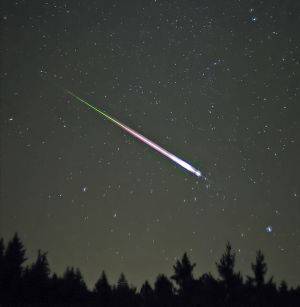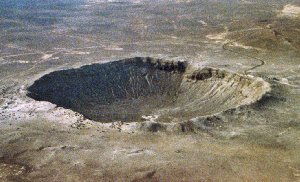Difference between revisions of "Meteoroid"
(added link) |
|||
| Line 2: | Line 2: | ||
[[File:Meteor crater.gif|thumb|right]] | [[File:Meteor crater.gif|thumb|right]] | ||
| − | A '''meteoroid''' is a small sand- to boulder-sized particle of astronomical debris in the [[Solar system]], smaller than an asteroid. <br>The visible path of a meteoroid that enters a planet's atmosphere is a meteor, commonly called a "shooting star" or "falling star". Upon reaching the ground, a "meteor" is then called a "meteorite." | + | A '''meteoroid''' is a small sand- to boulder-sized particle of astronomical debris in the [[Solar system]], smaller than an [[asteroid]]. <br>The visible path of a meteoroid that enters a planet's atmosphere is a meteor, commonly called a "shooting star" or "falling star". |
| + | * Upon reaching the ground, a "meteor" is then called a "'''meteorite'''." | ||
| Line 18: | Line 19: | ||
===Impact=== | ===Impact=== | ||
| − | Meteoroid collisions with solid Solar System objects create impact craters, which are the dominant geographic features of many objects. On planets and moons with active surface geological processes, visible impact craters may become eroded, buried, or transformed by tectonics over time. | + | Meteoroid collisions with solid Solar System objects create impact craters, which are the dominant geographic features of many objects. <br> On planets and moons with active surface geological processes, visible impact craters may become eroded, buried, or transformed by tectonics over time. |
Latest revision as of 12:35, 21 September 2022
A meteoroid is a small sand- to boulder-sized particle of astronomical debris in the Solar system, smaller than an asteroid.
The visible path of a meteoroid that enters a planet's atmosphere is a meteor, commonly called a "shooting star" or "falling star".
- Upon reaching the ground, a "meteor" is then called a "meteorite."
Size
Ranging in size from small grains to one-meter-wide objects, objects smaller than this are classified as "micrometeoroids," or simply, space dust. Most are fragments from comets or asteroids, whereas others are collision impact debris ejected from bodies such as moons or other planets.
Atmosphere
The entry of meteoroids into Earth's atmosphere produces three main effects: ionization of atmospheric molecules, dust that the meteoroid sheds, and the sound of its passage. During the entry of a meteoroid or asteroid into the upper atmosphere, an ionization trail is created, where the air molecules are ionized by the passage of the meteor. Such ionization trails can last up to 45 minutes at a time. These particles might affect climate, both by scattering electromagnetic radiation and by catalyzing chemical reactions in the upper atmosphere.
Sound generated by a meteor in the upper atmosphere of a planet, such as a sonic boom, typically arrives many seconds after the visual light from a meteor disappears. Occasionally, "crackling," "swishing," or "hissing" sounds have been reported, occurring at the same instant as a meteor flare.
Impact
Meteoroid collisions with solid Solar System objects create impact craters, which are the dominant geographic features of many objects.
On planets and moons with active surface geological processes, visible impact craters may become eroded, buried, or transformed by tectonics over time.

